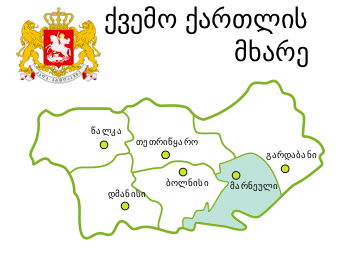Marneuli Municipality
Marneuli (Georgian: მარნეულის მუნიციპალიტეტი, Azerbaijani: Marneuli Bələdiyyəsi) is a district of Georgia, in the region of Kvemo Kartli. Its main town is Marneuli.

Location
Marneuli District is situated in south-east part of country near to border with Azerbaijan and Armenia. Area of district amounts 935 km².[1] Most part of its territory is located in Marneuli lowland (between 350–600 meters above sea level). Highest point is Garadagh mount (1416 m.)
Administrative division
Marneuli District consists of 2 city (Marneuli and Shulaveri) and 72 villages. Largest villages are Sadakhlo and Kizilajlo. In 51 villages predominate ethnic Azeris, in 11 – Armenians, in 8 – Georgians and in 1 – Greeks.[2]
Demography
According to Georgian Statistics Department at the beginning of 2009 population of Marneuli District was 123.5th. or 2,8% of total population of Georgia. 49,4% of inhabitants are males, 50,6% females.[3] In accordance with population census in 2002 Azeris have been predominating with 83.1% at the ethnic structure of inhabitants. Georgians was 8% and Armenians 7.9%.[4]
Economy
After the collapse of Soviet Union economy of Marneuli broke down in ways similar to other regions of country. Soviet economic policies employed people in industries that could not survive competition in a free market and encouraged industrialization in areas where it did not belong. The Marneuli area is littered with polluted and abandoned factories that are the remnants of Soviet economic policy. At present Marneuli is known as agricultural region. In 2006 Marneuli owned share 78% of tobacco, 11% of vegetables and 4% of meat production around the Georgia.[5] The largest employer in the Marneuli area is the Marneuli Food Company which bottles and sells items like pickles and ketchup.
Culture
At present in Marneuli it is functioning 87 state and 1 non-state secondary school, 4 college, 4 high education enterprises (university), 67 libraries, 2 theaters, 2 museums and 1 TV.[6]
References
- http://www.statoids.com/yge.html
- Rural population of Georgia (in Georgian language) Archived November 24, 2007, at the Wayback Machine
- Population by municipalities for the beginning of the year in Georgia Archived November 13, 2009, at the Wayback Machine
- Summary of population census 2002 in Georgia (in Georgian language) Archived March 6, 2009, at the Wayback Machine
- http://www.statistics.ge Statistics Department of Georgia
- http://www.kvemokartli.gov.ge Official site of Kvemo Kartli mkhare
| Wikimedia Commons has media related to Marneuli Municipality. |